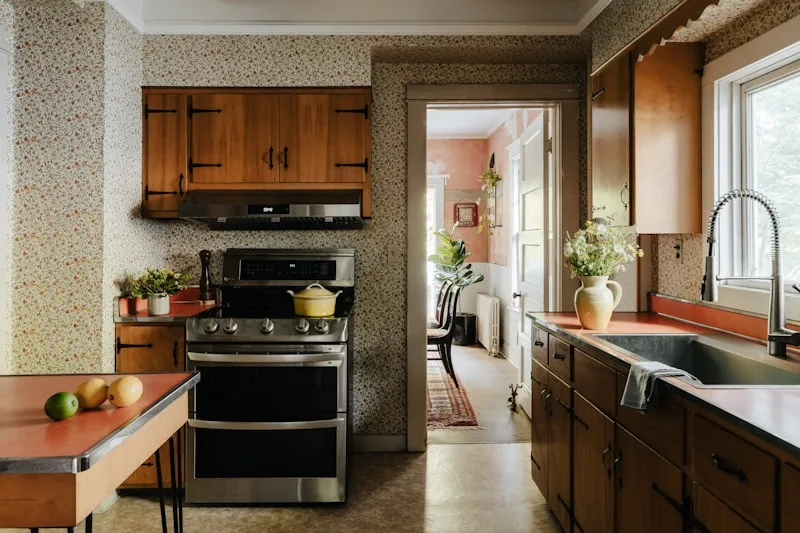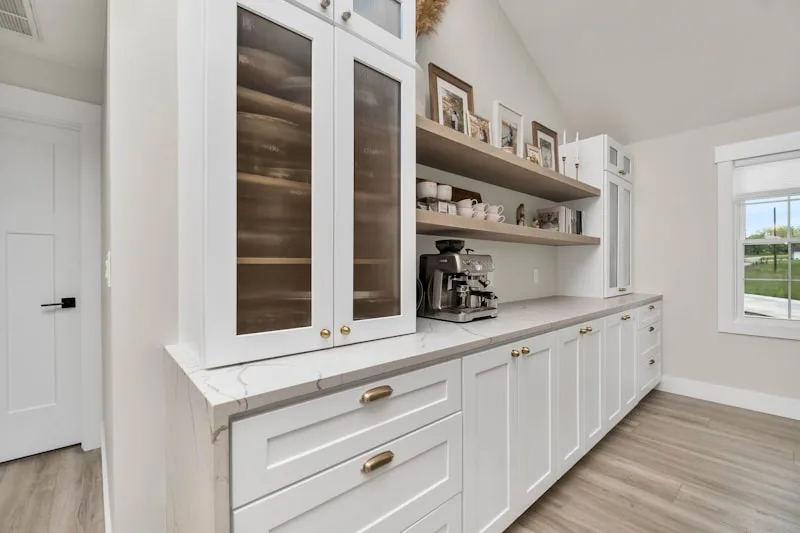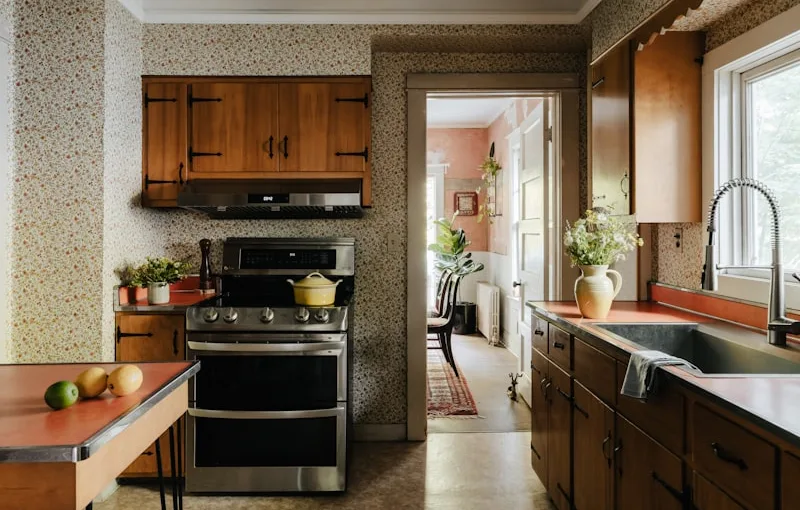Imagine your cabinets as a blank canvas. A glaze can enhance their natural beauty, highlighting the wood grain and adding a touch of sophistication. It’s like putting on a pair of stylish sunglasses—suddenly, everything looks better! Plus, glazing can help hide imperfections, making your cabinets look brand new even if they’ve seen better days.
Now, how do you effectively glaze those cabinets? First, start with a clean slate. Remove all the cabinet doors and hardware, and give everything a good scrub. Next, choose your glaze color. A darker glaze can create a rich, dramatic effect, while a lighter one can add a soft, airy feel. Once you’ve picked your shade, it’s time to get to work!
Apply a base coat of paint, letting it dry completely. Then, using a brush or a rag, apply the glaze in small sections. Work it into the grooves and crevices, almost like you’re giving your cabinets a gentle massage. Don’t be afraid to experiment! You can wipe off excess glaze to achieve your desired look. Finally, seal the deal with a clear topcoat to protect your masterpiece.
Transform Your Kitchen: The Art of Glazing Cabinets for a Stunning Finish
So, what exactly is glazing? Think of it as giving your cabinets a stylish makeover, much like how a fresh coat of paint can revitalize a tired room. Glazing involves applying a translucent layer over your existing cabinet finish, enhancing the texture and depth. It’s like adding a filter to your favorite photo—suddenly, everything looks more vibrant and polished.
Now, you might be wondering, “Is glazing right for my kitchen?” Absolutely! Whether you have traditional wooden cabinets or sleek modern ones, glazing can work wonders. It’s perfect for highlighting intricate details, like the grain of the wood or the carvings on your cabinet doors. Plus, it’s a fantastic way to add a touch of personality. Want a rustic farmhouse vibe? Go for a warm, earthy glaze. Dreaming of a chic, contemporary look? A cool, muted glaze can do the trick.
The best part? Glazing is a DIY-friendly project. With a little patience and the right materials, you can transform your kitchen without breaking the bank. Just imagine the satisfaction of stepping back and admiring your handiwork, knowing you’ve created a stunning focal point in your home. So, are you ready to roll up your sleeves and dive into the world of cabinet glazing? Your dream kitchen is just a brushstroke away!
Glazing 101: Why Your Kitchen Cabinets Deserve a Makeover
Imagine your cabinets as a blank canvas. A glaze is the magic paint that adds depth and character, enhancing the natural beauty of the wood. It’s like putting on a pair of sunglasses that make everything look a little cooler. With a variety of colors and finishes available, you can create a look that’s uniquely yours. Want a rustic farmhouse feel? Go for a warm, earthy glaze. Dreaming of a sleek, modern kitchen? A glossy finish can do wonders!
But why stop at aesthetics? Glazing also offers protection. Think of it as a shield against the daily wear and tear of kitchen life—spills, splatters, and the occasional curious toddler. It’s like giving your cabinets a suit of armor, ensuring they stay looking sharp for years to come.
And let’s not forget about the DIY aspect! Glazing is a fun project that you can tackle over a weekend. With just a few supplies and a little elbow grease, you can breathe new life into your kitchen. Plus, there’s something incredibly satisfying about stepping back and admiring your handiwork.
Unlocking the Secrets: How to Glaze Kitchen Cabinets Like a Pro
First off, think of glazing as the cherry on top of your cabinet makeover. It’s that magical touch that adds depth and character, transforming plain wood into a work of art. Imagine your cabinets as a blank canvas; glazing is the paint that brings them to life. But before you grab that brush, prep work is key. Start by cleaning your cabinets thoroughly—think of it as giving them a spa day. Dust, grease, and grime don’t stand a chance against a good scrub!
Once your cabinets are squeaky clean, it’s time to choose your glaze. You can go for a classic clear glaze to enhance the natural wood grain or opt for a tinted glaze to add a splash of color. Picture it like choosing the perfect outfit; the right glaze can make all the difference in how your cabinets shine.
Now, here comes the fun part—application! Use a brush or a rag to apply the glaze, working it into the crevices and details. It’s like giving your cabinets a gentle massage, allowing the glaze to settle into every nook and cranny. Don’t rush this step; take your time to ensure an even coat. And remember, less is more! You can always add more glaze, but it’s tough to take it away once it’s on.
From Dull to Dazzling: The Benefits of Glazing Your Kitchen Cabinets
Glazing is like giving your cabinets a stylish makeover. It’s a technique where a translucent layer is applied over the base color, adding depth and richness. Think of it as putting on a pair of sunglasses that enhance the colors around you. Suddenly, those plain cabinets become vibrant and full of character!
One of the biggest benefits of glazing is that it highlights the intricate details of your cabinetry. If you have beautiful wood grain or unique carvings, glazing can accentuate these features, making them pop. It’s like adding a spotlight to your favorite artwork—suddenly, it’s the star of the show!
Not only does glazing improve aesthetics, but it also offers a layer of protection. Just like sunscreen shields your skin from harmful rays, a good glaze can protect your cabinets from everyday wear and tear. It helps resist stains and moisture, keeping your kitchen looking fresh and clean for longer.

And let’s not forget about versatility! Glazing comes in various colors and finishes, allowing you to customize your cabinets to match your style. Whether you’re going for a rustic farmhouse vibe or a sleek modern look, there’s a glaze that can help you achieve your dream kitchen.
So, if you’re ready to turn your kitchen from dull to dazzling, consider glazing your cabinets. It’s a simple yet impactful way to breathe new life into your space, making it a place where you’ll love to cook, gather, and create memories.
Step-by-Step Guide: Mastering the Glazing Technique for Kitchen Cabinets
First things first, gather your supplies. You’ll need a good quality glaze, a brush, a clean rag, and some painter’s tape. Think of the glaze as the icing on your cake—it’s what makes everything pop! Start by prepping your cabinets. Clean them thoroughly to remove any grease or grime. It’s like giving your canvas a fresh coat of paint before you start your masterpiece.
Next, apply a base coat if you want a specific color underneath. This is where you can get creative! Once that’s dry, it’s time for the fun part: glazing. Dip your brush into the glaze and apply it in small sections. Don’t worry about being perfect; the beauty of glazing is in its imperfections. Use your rag to wipe away excess glaze, allowing it to settle into the grooves and details of your cabinets. It’s like giving your cabinets a gentle hug, highlighting their unique features.
As you work your way around the kitchen, take a moment to step back and admire your progress. Are you feeling the excitement yet? Once you’ve glazed all your cabinets, let them dry completely. This is the moment where patience pays off. Finally, seal your work with a clear topcoat to protect your beautiful new finish. Just like that, you’ve turned your kitchen into a space that feels fresh and inviting!
Elevate Your Space: The Impact of Glazed Cabinets on Kitchen Aesthetics
Glazed cabinets are more than just a pretty face. They add depth and dimension, making your kitchen feel larger and more inviting. Think of them as the perfect accessory to your home—like a statement necklace that ties an outfit together. Whether you’re going for a rustic farmhouse vibe or sleek modern chic, glazed cabinets can adapt to your style, enhancing the overall aesthetic.
But let’s talk about versatility. You can choose from a variety of colors and finishes, allowing you to express your personality. Want a soft, muted look? Go for a light glaze over a natural wood. Craving something bold? A dark glaze can add drama and sophistication. It’s like painting your kitchen with your unique flair!
And here’s the kicker: glazed cabinets are not just about looks. They’re practical too! The glaze acts as a protective layer, making them easier to clean and maintain. So, while you’re busy whipping up your next culinary masterpiece, you won’t have to stress about stubborn stains or spills.
Glazing Kitchen Cabinets: A Cost-Effective Way to Revitalize Your Home

Glazing is like giving your cabinets a stylish makeover. It’s a technique that adds depth and character, enhancing the natural beauty of the wood while providing a protective layer. Think of it as a filter for your cabinets, similar to how a good Instagram filter can make your photos pop! With a variety of colors and finishes available, you can easily find a glaze that complements your kitchen’s vibe, whether it’s rustic charm or sleek modernity.
Now, you might be wondering, “Is this really cost-effective?” Absolutely! Compared to a full cabinet replacement, glazing is a fraction of the cost. You can achieve that high-end look without the high-end price tag. Plus, it’s a DIY-friendly project. If you’ve got a little time and some basic tools, you can tackle this project yourself, saving even more money. Just imagine the satisfaction of saying, “I did that!” every time you walk into your kitchen.
Frequently Asked Questions
How Do I Prepare Cabinets for Glazing?
To prepare cabinets for glazing, start by cleaning the surfaces thoroughly to remove any grease or dirt. Next, sand the cabinets lightly to create a smooth surface and improve adhesion. After sanding, wipe down the cabinets with a damp cloth to remove dust. Apply a primer if necessary, and ensure the cabinets are completely dry before applying the glaze. This preparation will help achieve a professional finish.
How Do I Maintain Glazed Kitchen Cabinets?
To maintain glazed kitchen cabinets, regularly dust and wipe them with a soft, damp cloth to remove grease and grime. Avoid harsh chemicals; instead, use a mild soap solution for deeper cleaning. Ensure to dry the surfaces immediately to prevent water damage. For added shine, consider applying a furniture polish specifically designed for wood finishes. Regular maintenance will keep your cabinets looking fresh and vibrant.
What Techniques Should I Use for Effective Glazing?
To achieve effective glazing, focus on techniques such as applying thin, even layers of glaze, using a soft brush or sponge for smooth application, and ensuring proper surface preparation. Experiment with different glazing mediums to enhance transparency and depth. Allow adequate drying time between layers to prevent muddiness, and consider using a clear glaze to unify the finish.
What Are the Benefits of Glazing Kitchen Cabinets?
Glazing kitchen cabinets enhances their appearance by adding depth and richness to the finish. It highlights the details of the cabinet design, making them more visually appealing. Additionally, glazing can help conceal minor imperfections and provide a protective layer, increasing durability. This technique also allows for customization, enabling homeowners to achieve a unique look that complements their kitchen decor.
What Materials Do I Need for Glazing Kitchen Cabinets?
To glaze kitchen cabinets, you will need a few essential materials: a high-quality glaze, a paintbrush or foam applicator for even application, a clean cloth for wiping off excess glaze, painter’s tape to protect areas you don’t want to glaze, and a clear topcoat for sealing the finish. Additionally, ensure you have sandpaper for surface preparation and a primer if you’re working with raw wood.
